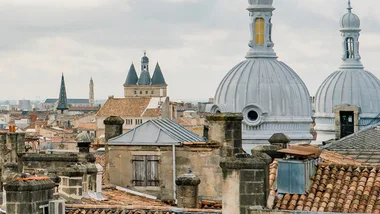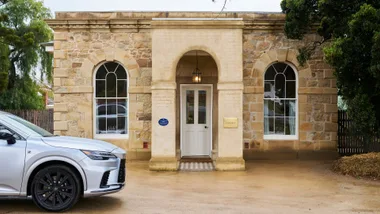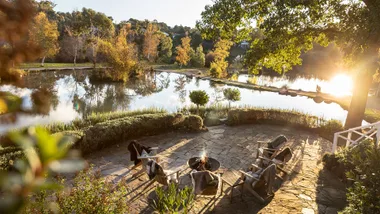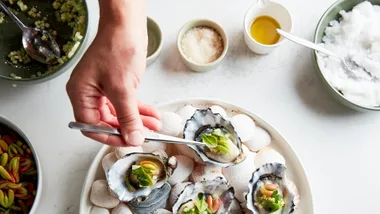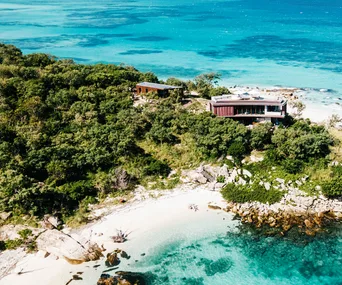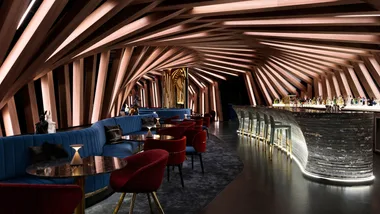I first went to Versilia one summer in the early 1990s. I liked the mild, sunny climate and often returned. In recent years, however, I hadn’t been there as much as I’d have liked and I was growing sentimental about the place. Then last year, unexpectedly, I had reason to pass through not once, not twice, but three times. It was good to be back.
The name Versilia refers to the strip of land hemmed tightly between the sea and the mountains in the province of Lucca in north-west Tuscany. During the Belle Époque, the strip – and its largest city, Viareggio, in particular – attracted swarms of well-heeled tourists from all over Europe. Today the deluge has dwindled to a trickle, but the area is still popular with Italians. They go in summer for the sun and beaches, but, as is the case everywhere along the Italian coastline, there’s enough culture and history and natural beauty to woo the discerning traveller at any time of the year.
Where to stay, eat, shop and more in Versilia.
Take the mountains, the spiry Apuan Alps – they have many stories to tell. When I saw them looming in the distance for the first time, I thought the white patches on their sharp peaks were snow. I was wrong; they are marble – the famous Carrara marble Michelangelo travelled from Florence to buy for his statues, most notably David. Marble quarrying was an arduous business at the time; centuries later, miners rebelled against their terrible working conditions and the quarries became the cradle of Italian anarchism. “Even the stones are anarchists,” remarked Galileo Palla, one of the movement’s leaders.
Widespread poverty triggered mass emigration in the late 19th century. Most of the Italian ice-cream parlour and fish-and-chip shop owners in central Scotland and north-west England, where I come from, are descendants of emigrants from the Apuan Alps and thereabouts. In the last war, the same mountains were the scene of partisan ambushes and bitter German reprisals, some of which are recounted by Spike Lee in his 2008 film Miracle at St Anna. Today the memory of these gruesome events gives them an air of poignancy. The coastal strip exudes history, too. Originally an area of malarial marshland, Versilia was inhabited by the Etruscans from the Iron Age, then from the 3rd century BC by the Apuan Ligurians, who were subsequently ousted by the Romans after many a bloody battle. In the Middle Ages, pilgrims followed the Via Francigena through Versilia to Rome, and later the area became the Republic of Lucca’s only access to the sea. As a result of reclamation work in the 18th century, the shoreline began to assume its present-day appearance: miles of golden beaches and sprawling parasol pine woods. A century later, Versilia had become one of the most fashionable tourist destinations in Europe.
The main towns are Forte dei Marmi, Pietrasanta, Camaiore and Viareggio, which run into each other in that order from north to south. At the southernmost boundary of Versilia is Lake Massaciuccoli, six kilometres inland, now a fishing and nature reserve.
Last spring I was strolling by the lakeside in the early afternoon sunshine when I stopped to light a cigarette.
“Always smoking,” I heard someone say behind me. I turned to find a complete stranger, an elderly man, sitting on a bench with a blowsy blonde woman.
“Who me?” I asked, surprised.
“No, sorry, I was speaking to my friend here about Giacomo Puccini,” said the man. “In photos he often has a cigarette in his mouth or between his fingers. He was an inveterate smoker. I know all about him. Opera’s my passion.”
The villa where Puccini lived for about 30 years was just metres from where we were speaking. There, in seclusion, he composed many of his operas, inspired by the “luxurious, fantastic sunsets” over the lake. One can imagine him at his desk – puffing on a fag, no doubt – travelling in his imagination to Japan in Madama Butterfly or Paris in La Bohème or the American Wild West in La Fanciulla del West. His mind wandered but Lake Massaciuccoli was his home, a place where he could use “my second favourite instrument, my rifle” to go hunting in “the splendid patches of scrubland down towards the sea, inhabited by fallow deer, wild boar, hares, rabbits, pheasants and woodcock”. Footage has recently been discovered of Puccini, dressed in a three-piece suit and a trilby, shooting into the reed brakes from a rowing boat. He was a great gourmet and his favourite wild fowl was folaga, or coot. A dish, folaghe alla Puccini – coot stewed with a mirepoix and served on toast – was named after him. It’s hard to find these days, at least in the restaurants of the area.
Villa Puccini is now a museum and alongside it a chapel contains the tombs of the composer, his wife and his son. The Puccinis originated from Celle, a village in the mountains not far away, now rechristened Celle dei Puccini. There the family home has been converted into a museum, too. Its exhibits include the piano on which the great man composed part of Madama Butterfly and the phonograph given to him as a present by Thomas Edison.
As for the man on the bench, he explained he had been born and bred in the nearby town of Torre del Lago. A mélomane, an opera buff, from Puccini’s adopted town: what comes first, the chicken or the egg? I asked the man what the building with the blue girders was to our left. I thought it was some sort of factory. It certainly spoiled the view over the lake.
“No, it’s the Teatro Puccini,” he replied. “It’s where the Festival Pucciniano is held every year, from July to August. People come from all over the world to attend.” Puccini has left traces everywhere in Torre del Lago and its purlieus. The Viale Giacomo Puccini is the avenue that leads from the town centre to the lake. There’s also a Via Turandot, a Via Tosca and a Via Bohème. At one point I took a wrong turn in the car and found myself in Via Butterfly. What a charming name for a street, I thought.
Puccini also had a townhouse off the seafront in Viareggio, a few kilometres to the north. On winter evenings he had his own a table at the twin-towered Gran Caffè Margherita, the café-chantant where he would drink hot rum punch with his cronies – other celebrities of the day including Guglielmo Marconi, Arturo Toscanini and Galileo Chini. The lattermost was an architect who helped found the so-called Liberty style, Italy’s take on Art Nouveau, and designed the sets for the premieres of Turandot, Manon Lescaut and Gianni Schicchi at the New York Metropolitan Opera. Until the early 19th century, Viareggio, named after the Via Regia, the old military road, had been nothing more than a fishing village. Then boatyards were developed along the Canale Burlamacco under the 15th-century Torre Matilde. Yacht building is still one of the town’s main industries and the canal doubles as a pleasure harbour. In 1822, Shelley was cremated on the beach after drowning while sailing in the Gulf of La Spezia.
Just six years later, two bathing establishments were built nearby that sealed Viareggio’s future as Tuscany’s principal seaside resort. By the middle of the century, the first beach huts and umbrellas began to appear and the therapeutic qualities of the sea and sunshine were drawing tourists from all over Italy and beyond. “A modern town built on a plain of mud and sand” is how Norman Douglas disparagingly described the new-look Viareggio, but there was no doubting its success. In the summer of 1871, 35,000 holidaymakers flocked to the booming resort, by now nicknamed “a perla del Tirreno”, the pearl of the Tyrrhenian.
The promenade, the Passeggiata Viale Regina Margherita, extends three kilometres along the sea – a long sequence of cafés and shops and cinemas topped by pinnacles and domes and towers of all shapes and sizes. In 1917 it was largely destroyed by fire but was subsequently rebuilt in a mixture of architectural styles: Liberty, Art Deco, eclectic. The bizarre, phantasmagorical façades of its buildings give the promenade the look of a film set. It reminds me of the reconstruction of turn-of-the-century Atlantic City in the HBO series Boardwalk Empire.
On the other side of the road, grand hotels sprang up to meet the demands of fin-de-siècle élite tourism. The Grand Hotel Royal, the Hotel Excelsior, the Palace Hotel, the Grand Hotel Principe di Piemonte, the Hotel Plaza e de Russie – all monumental, all architecturally stunning, all still good places to stay.
Built in 1871, the Hotel Plaza e de Russie is the oldest on the strip. Its elegant reception rooms decorated with Murano glass chandeliers and antique furniture evoke the Belle Époque, when the Russian nobles to whom its name pays homage spent long leisurely holidays in Viareggio. More than a hundred years later, wealthy Russians have returned. According to one story I heard recently, a local youth who offered to light a Russian’s cigar received a tip of 100 euros.
The Grand Hotel Principe di Piemonte has always been a favourite haunt of aristocrats, intellectuals and artists. It began life in the early 1920s as the Select Palace Hotel and took its present name in 1938. The year after, it inaugurated its own private beach. Today, its two-star Piccolo Principe restaurant serves the refined creations of chef Giuseppe Mancino in a fifth-floor terrace dining room with a breathtaking view of the sea to the front and the Apuan Alps to the rear. Not surprisingly, fish prevails on the menu. Viareggio’s fish market, in fact, is famous all over northern Italy, and restaurateurs come from as far away as Milan to source produce here.
The local dish par excellence is cacciucco(pronounced “cachuco”) – a soup once made with fish trapped in the mesh of the nets (hence unsellable), olive oil, garlic, chilli and tomato paste. Ladled over toasted bread, it used to be reinforced with a generous splash of red wine. Adulterated contemporary takes on the recipe – without the wine – can be found in Versilia’s best seafood restaurants: La Darsena, say, or Trattoria Buonamico or Da Romano.
Out of town, the fare in the old days used to consist mainly of pulses and cereals and chestnuts – what’s known as cucina povera. Garmugia is a soup of spring onions, artichokes, peas, fava beans, and pancetta; a winter version, zuppa Lucchese, is made with dried borlotti beans and farro or spelt. Tordelli are the typical pasta of the area, half-moon shapes filled with minced beef and pork and usually served with a ragù or simply with butter and sage.
Today, Viareggio buzzes all year round, not only in summer. In October there’s an historic yacht regatta, in February a spectacular carnival in which enormous papier mâché floats, many inspired by satirical themes and often in the form of caricatures of contemporary politicians, parade along the seafront. Then there’s the Premio Viareggio, one of Italy’s most prestigious literary awards, which has the critics’ tongues wagging from one year to the next.
Northwards, Viareggio runs into Lido di Camaiore – the seaside extension of the inland town of Camaiore, worth visiting for its medieval walls and lovely Romanesque churches. From the Lido the coastal drag is lined on one side by bathing establishments, on the other by a pine forest interspersed with residences of greater or lesser grandeur – mock-Gothic follies, Jugendstil mansions, large modern piles with swimming pools – all attenuated by Mediterranean forms and colours.
As World War II came to an end, the forest became a cour des miracles where black marketeers and prostitutes plied their trades and Allied soldiers got drunk and brawled or deserted. A decade or so later, when Italy began to enjoy an economic boom, holidaying families would spend afternoons in the cool shade of the woods after mornings on the beach. There were cycle paths and roundabouts and puppet theatres for the kids, while for adults there was a vibrant night life and music scene. Clubs such as La Capannina at Forte dei Marmi and La Bussola at Pietrasanta appeared, and the likes of Edith Piaf, Louis Armstrong, Ray Charles and Paul Anka came to perform.
Today, the bathing establishments, with their refined bars and restaurants, cabanas and well-spaced sun umbrellas, are among the most exclusive in Italy. One of them, Twiga, was established by Marcello Lippi, the Italian soccer team’s 2006 World Cup-winning manager. Another, La Romanina, belongs to Italian goalkeeper Gigi Buffon and his family. Typical holidaymakers are well-off and locals refer to them as signori not as turisti.
Pietrasanta was the first Versilian town I really got to know. Someone gave me the address of an agriturismo there and I began to frequent the place. If Norman Douglas called Viareggio “the least picturesque of all cities in the peninsula”, complaining that “it has not even a central piazza!”, Pietrasanta is easily the most “Tuscan” of towns in Versilia. It certainly has a central piazza, the utterly lovely Piazza del Duomo, where architectural styles from different eras combine to felicitous effect in monuments such as the 14th-century Duomo di San Martino with its Renaissance campanile and the Romanesque Chiesa di Sant’Agostino with its Pisan colonnade.
Pietrasanta is one of the world’s most important centres for the working of marble and home to renowned artists. One is the Colombian Fernando Botero, famous for his oversized figures; another was the late Polish sculptor Igor Mitoraj, whose huge bodiless heads and headless bodies were occupying the Piazza del Duomo during my last visit. Statues ancient and modern are everywhere in Pietrasanta: on street corners, in gardens, even at the centre of roundabouts. More than an art town, it’s a living art gallery.
At its lido, Marina di Pietrasanta, sculpture is replaced by literature. Every summer, La Versiliana, a large villa in the pine wood, hosts an international cultural festival of talks and round tables with writers and journalists. There’s also an open-air theatre; I once saw an excellent production of Hamlet, or rather Amleto, there.
In the first decade of the last century, the largerthan-life poet, would-be superman and legendary lover Gabriele D’Annunzio spent summers at the Versiliana where, besides walking his 29 dogs, he entertained one in his long sequence of mistresses, Eleonora Duse, “la divina”, the leading actress of her day. The two would ride for hours along the sand.
In the 1930s, another love affair caused a society scandal further up the beach at Forte dei Marmi, named after the red-brick fortress built to protect the small harbour and the pier where ships would load marble dragged down from the quarries by teams of oxen. It was here that distinguished journalist and dandy Curzio Malaparte wooed and won over Virginia Agnelli, wife of Edoardo Agnelli of Fiat motors fame and mother of Gianni, later to become a leading player on the international jet set in his own right. The Agnellis had a villa in Forte – previously a summer retreat for mainly northern European artists and intellectuals, among them Thomas Mann – and helped put it on the map. Other northern industrialists followed in their footsteps and began to prefer Forte even to destinations as desirable as Capri and Taormina.
Forte was the place to be seen, and it still is today; l’importante è esserci, “the important thing is being there”, goes the mantra. With its tree-lined avenues, smart villas hidden behind neatly pruned hedges, well-kept public gardens, chic bars and restaurants and designer shops – not to mention a stylish fashion market on Wednesdays – Forte is one of the most stylish resorts in Italy, certainly the most stylish in Versilia.
Further north along the coast are the larger, more industrial cities of Massa and Carrara, also dominated by the two Ms: mare e marmo, sea and marble. Both have interesting sights and both are good bases for excursions into the mountains. But lovers of art and culture might also like to bear in mind that the more illustrious Lucca and Pisa are only half an hour away by car. To visit them would be to step into a different world, and I would have a different story to tell.

